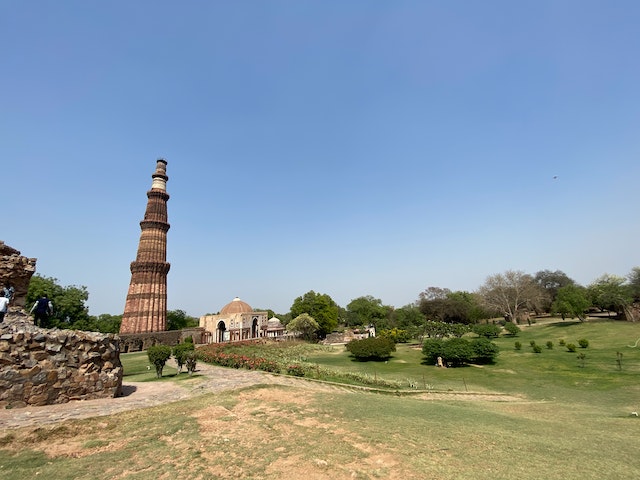
Uncovering the Mysteries of Qutab Minar: Delhi’s Towering Marvel
The Qutab Minar, an architectural marvel withstood centuries of history, is located in the center of Delhi, the vibrant capital of India. Not merely a tower, this famous building—a UNESCO World Heritage Site—is a tribute to India’s rich history and the many tales woven into its architecture. Our blog, “Uncovering the Mysteries of Qutab Minar: Delhi’s Towering Marvel,” takes readers on a fascinating architectural and historical voyage. Explore the intriguing mystery that awaits to be revealed as we explore the history, the dexterous carvings, and the mysterious inscriptions that make this towering minaret a representation of India’s eternal legacy.
A Brief History of the Qutab Minar
The Qutab Minar is a majestic red sandstone and marble tower rising to a height of 73 meters. Its layers conceal a fascinating history that goes back to the 12th century. Qutb-ud-din Aibak, the first Muslim king of Delhi, commissioned the construction of this imposing building, which served as a location to hear the call to prayer and a symbol of Islamic power. Still, the tower was finished at the time of Iltutmish. Qutab Minar has seen many kingdoms and empires come and go throughout the ages, making it an intriguing microcosm of Delhi’s historical development. Both historians and tourists are enthralled by its unique architecture and enigmatic inscriptions, which immerse them in a historical narrative.
The Construction of the Qutab Minar
The Qutab Minar’s building is evidence of the era’s architectural brilliance. Constructed predominantly from red sandstone and white marble, this imposing wonder is a remarkable illustration of Indo-Islamic architecture. The tower is divided into five stories, all with beautiful calligraphy and complex carvings. The building’s architecture incorporates Persian and Hindu inspirations and combines Indo-Islamic features.
Notably, the fourth and fifth levels exhibit Persian elements, such as the unique balcony and Arabic inscriptions, whereas the first three stories are constructed in a conventional Indian manner. The extraordinary artistry of the artists who worked on this enormous undertaking is demonstrated by the accuracy of the building, especially considering that it was done long before modern technology.
The Architecture and Design of the Qutab Minar
The Qutab Minar’s architecture and design bear witness to the amalgamation of various influences that molded medieval India. This imposing work of art displays a tasteful fusion of Persian and Indo-Islamic architectural forms. Its facade, composed of fluted red sandstone, its elaborate bands of Quranic calligraphy in gorgeous Naskh script, and its exquisite decorative patterns are among its most notable characteristics. Persian aesthetics may be seen in the balconies and arches at the top.
Fundamentally, the Qutab Minar exemplifies India’s pluralistic architectural legacy by skillfully fusing Islamic and Hindu features. Visitors are enthralled by the minaret’s majestic design and majestic height, which offer insight into the time’s creative prowess and cultural richness.
The Mysteries and Legends of the Qutab Minar
With its rich history and folklore, the Qutab Minar is not without its secrets. The reason it was built is one of the longest-standing mysteries. However, it is mainly understood to have been a triumph tower; some people theorize that it may have been an observatory for astronomy. Another mystery is the iron pillar next to the minaret, which has withstood corrosion for over a thousand years. It’s said that your desire will come true if you stand facing it and can wrap your arms around it. The atmosphere is alive with the whispers of many tales and mysteries yet to be solved as guests explore this old masterpiece.
The Qutab Minar is a UNESCO World Heritage Site
The Qutab Minar and the surrounding structures received the UNESCO World Heritage Site designation in 1993. This esteemed distinction highlights this masterpiece’s historical and architectural value from the 12th century. With its blend of Persian and Indo-Islamic architectural styles, the Qutab Minar complex is crucial to India’s cultural history. Its designation as a World Heritage Site attests to the diversity and blending of civilizations that have enhanced the Indian subcontinent over the millennia and serve as a symbol of architectural genius. Nowadays, tourists worldwide swarm to the Qutab Minar to take in its magnificence and help preserve this famous building.
Visiting the Qutab Minar Today
Today’s visitors to the Qutab Minar can fully immerse themselves in the rich fabric of culture, architecture, and history. This UNESCO World Heritage Site in Delhi beckons guests with its imposing majesty and tranquil environs. Travelers may marvel at the minaret’s remarkable height, discover the complexities of Indo-Islamic and Persian design, and enjoy the Quranic inscriptions. Other historical landmarks in the compound include the Quwwat-ul-Islam Mosque and the Iron Pillar. It’s a location where the past and present converge, enabling guests to engage with India’s remarkable architectural heritage and rich history.
The End
Finally, our tour of Delhi’s majestic Qutab Minar shows us that this famous building is more than simply a monument—instead, it’s a living representation of India’s rich history and cultural heritage. All who visit the Qutab Minar are captivated and motivated by its mysterious design, which combines several architectural styles and the stories surrounding it.
It attracts tourists and history buffs worldwide as a symbol of India’s rich cultural legacy and as a UNESCO World Heritage Site. Its timeless appeal stems from its imposing presence and the mysteries and tales it conceals, only waiting to be unearthed by anyone curious to learn what is beyond its old stones.


